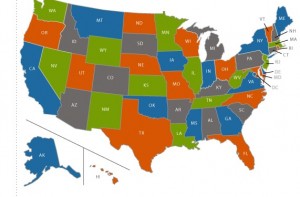College Admissions
College Admissions
Preparing for College
The Best College for You
What to Study
Applications
Education Options
Education Options
Private Universities
Public & State Universities
Community Colleges
Scholarships
Scholarships
African American Scholarships
Latino Scholarships
Native American Scholarships
Women Scholarships
College Grants
College Grants
Federal Grants
Merit Based Grants
Need Based Grants
Student Loans
Student Loans
Federal Student Loans
State Student Loans
No Co-signer Student Loans
Bad Credit Loans
Student Loan Consolidation
College Survival
College Survival
Financial Aid Tips
The Digital Student Blog
It is not quite two years removed from the point when the youth of America propelled a relative unknown senator into the White House. Yet, for many Americans, it seems like an eternity since Barack Obama was elected.
For those twenty-something’s who saw his election as a watershed moment, the current climate in Washington no doubt has them wondering why, once upon a time, they had such optimism. In fact, the partisanship being displayed by our elected officials may well be at an all time high.
 The shift has many suggesting that 2010 could well be the “Year of the Non-Youth Vote.” John Della Volpe, the Director of Polling at the Harvard University’s Institute of Politics, postulates just such a scenario.
The shift has many suggesting that 2010 could well be the “Year of the Non-Youth Vote.” John Della Volpe, the Director of Polling at the Harvard University’s Institute of Politics, postulates just such a scenario.
According to Della Volpe, for more than a decade the Harvard Institute of Politics study group has met regularly to discuss the current generations involvement in politics. Della Volpe insists that “the overarching narrative of the last ten years has been that of a new, potentially great generation — a generation that seemed intent on making an impact first as community volunteers and then in the voting booth.”
But in the aftermath of the economic downturn and the extreme partisanship overtaking Washington, it now appears that more than 70 percent of young voters are not sure that they will vote in the upcoming midterm elections. Furthermore, less than one-in-five Millennials aged 18 to 29 indicates that they are politically engaged as this year’s election approaches.
Discouraged, Like Most Americans
The result is extremely troubling though we might contend that Americans of all ages just might be thinking it is time to sit this election out. Without a doubt, the voters that were the catalyst for Obama’s election have gone from strong levels of optimism to extreme pessimism.
It is a sentiment that borders on despair, a feeling that comes when the populace becomes completely discouraged with politics. But as November 2nd approaches, Dell Volpe indicates that it is “not too late for young people, the great Millennial generation, to use the technology and tools that they invented to spread the word and encourage their friends and family members to spend five minutes to vote.”
He further notes that President Obama “challenged Americans to hold both him and other elected officials accountable” for their achievements or lack thereof.
We couldn’t agree more.
Time to Vote
 In simplest terms, now is the time for accountability for all of those currently in office. And those currently serving cannot be held accountable unless voters exercise their right to cast a ballot.
In simplest terms, now is the time for accountability for all of those currently in office. And those currently serving cannot be held accountable unless voters exercise their right to cast a ballot.
Now it is the time to set aside our discouragement, to stop making excuses for inaction. It is time for us to review the candidates, their records and their position on issues so as to be able to make an educated decision as to who is worthy of our vote.
America faces many difficult issues in the coming years: our debt load, our looming social security and medicare shortfalls, our need to make health care available to all, that it is not only about creating jobs but about a high quality of life for all citizens, etc. All represent challenges that demand elected officials who are willing to work collaboratively for the good of all people, not just a single segment of society.
For those at a loss as to who to consider, we would suggest trying to help eliminate the gridlock by looking at the progressive, middle of the road, candidates, as opposed to either those on the far left or right. In our view, candidates who postulate that only Republican ideals are good or that only Democratic ideas are worthy are simply not going to help us move forward as a country.
In other words, we challenge readers to consider both the people and their issues according to an independent set of standards as opposed to a simple assessment that has a person voting simply on party lines.
At the same time, it is not too late to read up on the other issues that are special items in your local community. If you are not sure what the issues are and where you or other people stand, get online and begin a Google search of those items coming up for consideration.
Check your local and other state papers as to where the editorial boards of these entities stand. With some very brief work you can get up to speed on all issues and how they affect you.
Ultimately, it is our duty as US citizens to enter our views at the ballot box come next Tuesday.
Yes, duty calls – so no excuses, make time to vote!
When it comes to earning a college degree, students must do a better job of shopping around.
 Unfortunately a new report from the Project on Student Debt confirms that the debt load for college graduates continues to escalate. For the most recent set of graduates for which full data is available, the Class of 2009, the average debt load increased yet another 6% from its 2008 levels.
Unfortunately a new report from the Project on Student Debt confirms that the debt load for college graduates continues to escalate. For the most recent set of graduates for which full data is available, the Class of 2009, the average debt load increased yet another 6% from its 2008 levels.
That puts the average student debt load for a graduate in 2009 at $24,000. That number becomes even more critical when one considers the unemployment rate for young college graduates rose from 5.8 percent in 2008 to 8.7 percent in 2009, the highest annual rate on record.
The Debt Load
Though the average debt load number is significant, it is imperative that students understand that the variability of debt from school to school and state to state is extremely large. Simply stated, students can significantly limit their accrued debt by choosing an appropriate school.
First of all, at the state level, debt at graduation from four-year colleges ranged from $13,000 to $30,000. The highest debt states continue to be concentrated in the Northeast while the lower debt states are primarily in the West.
But as great as the discrepancy is state-to-state, the variation from college to college is far greater. According to the report, the campus debt ranged from as little as $3,000 to a maximum of $61,500.
And while most tend to think that those with higher tuition are the culprits, the report found many examples of schools with high tuition rates and low debt. As a rule, however, those schools with higher tuition rates did post higher debts.
Most importantly, this data taken collectively indicates that the decision as to where to go to college and which specific college to attend can dramatically impact the final debt load of a graduating student.
Controlling Debt
 The increased debt load of students in the Northeast is attributed to a couple of factors. First, both private and public four-year colleges in the Northeast have higher than average tuition rates.
The increased debt load of students in the Northeast is attributed to a couple of factors. First, both private and public four-year colleges in the Northeast have higher than average tuition rates.
Second, the report notes that a larger than average share of students in the Northeast attend private nonprofit four-year colleges instead of public. The result of these two factors, both controllable factors for students, produce higher average debt loads for students in this region of the country.
The news out of New Hampshire is doubly troubling – the state ranks second in student debt load with an average of $29,443. In addition, a full 72% of graduates end up with some form of debt, a percentage that ranks the state 5th overall.
The District of Columbia ranks highest in average debt at $30,033. But another important factor is that a much lower percentage of students, 51%, graduate with some form of debt. That figure ranks the District of Columbia 38th overall.
Clearly, different choices by students impact this data immensely. The bottom line is that there are schools that consistently produce graduates with high levels of indebtedness and those where the opposite is true.
Private versus Federal Loans
The report also reveals some very interesting results when looking at the type of loans students take on when incurring their debt.
 We have often noted that other critical element in the loan process, the use of private versus federal loans to help fund the costs of college. Private loans lack the basic consumer protections and flexible repayment options that accompany federal student loans including deferment, income-based repayment, and the potential for loan forgiveness.
We have often noted that other critical element in the loan process, the use of private versus federal loans to help fund the costs of college. Private loans lack the basic consumer protections and flexible repayment options that accompany federal student loans including deferment, income-based repayment, and the potential for loan forgiveness.
Because private loans also typically have uncapped, variable interest rates, these loans generally cost more for those students who can least afford the additional expenses. Therefore private student loans continue to be one of the riskiest ways to pay for college and should be avoided by students if at all possible.
However, according to the report, about 33 percent of all bachelor’s degree recipients in ‘08 graduated with private loan debt. When all graduates were taken collectively, the average private debt totaled $12,550 for the ’08 grads.
Here again, the report details significant variation in private loans depending on the school. As but one example, only nine percent of the overall student debt at Indiana University-Northwest (IN) was composed of private loans, compared to 41 percent at Bowling Green State University-Main Campus (OH). Yet both of these colleges had very similar levels of overall borrowing.
The data once again reveals that at some schools students not only wind up with more debt, they amass more of the worst kind of debt a student can accumulate.
Message for Students
There are several key messages for students to take away from this recent report. Unless a student is from a family with unlimited means, all of the data points to the need for students to do their homework before applying and committing to a particular school.
In addition to the many key elements such as programming options, size of school, type of campus (rural or metro), etc., it is imperative that students carefully review the data from the Project on Student Debt. As with programming, not all colleges are created equal. With a little extra research, it is possible to choose a college that is known for helping you control your acquired debt even as you earn that all-important degree.
The problem today is that too many students are not doing their homework and in doing so, are mortgaging their future in the process of earning that coveted degree.
Schools with high levels of debt:
| High Debt – Public Schools | High Debt – Private Schools |
| Alabama A & M University | American University |
| Alabama State University | Buena Vista University |
| Bowling Green State University-Main Campus | Cleveland Institute of Art |
| Ferris State University | College for Creative Studies |
| Fort Valley State University | Eastern Nazarene College |
| Indiana University-Northwest | Florida Institute of Technology |
| Iowa State University | Green Mountain College |
| Langston University | Kettering University |
| Lincoln University of Pennsylvania | Lawrence Technological University |
| Maine Maritime Academy | Long Island University-Brooklyn Campus |
| Mansfield University of Pennsylvania | Minneapolis College of Art and Design |
| Minnesota State University-Moorhead | Ohio Northern University |
| Pennsylvania State University (multiple campuses) | Ringling College of Art and Design |
| Plymouth State University | Saint Joseph College |
| Temple University | Simmons College |
| University of Alaska Fairbanks | The College of Saint Scholastica |
| University of Maine | University of Dubuque |
| University of Michigan-Dearborn | Wheelock College |
| University of Minnesota-Duluth | Woodbury University |
| University of Nebraska Medical Center | Worcester Polytechnic Institute |
| University of New Hampshire-Main Campus |
Schools with low debt levels.
| Low Debt Schools | Type of School |
| Berea College | Private nonprofit, 4-year or above |
| Caldwell College | Private nonprofit, 4-year or above |
| California Institute of Technology | Private nonprofit, 4-year or above |
| Cameron University | Public, 4-year or above |
| College of the Ozarks | Private nonprofit, 4-year or above |
| CUNY College of Staten Island | Public, 4-year or above |
| CUNY Hunter College | Public, 4-year or above |
| Hampton University | Private nonprofit, 4-year or above |
| Kennesaw State University | Public, 4-year or above |
| Lamar University | Public, 4-year or above |
| Lane College | Private nonprofit, 4-year or above |
| New Mexico Institute of Mining and Technology | Public, 4-year or above |
| Princeton University | Private nonprofit, 4-year or above |
| Sam Houston State University | Public, 4-year or above |
| Southeastern Oklahoma State University | Public, 4-year or above |
| The Baptist College of Florida | Private nonprofit, 4-year or above |
| Tusculum College | Private nonprofit, 4-year or above |
| University of Wisconsin-River Falls | Public, 4-year or above |
| Western New Mexico University | Public, 4-year or above |
| Williams College | Private nonprofit, 4-year or above |
Click here for complete school data.
The word is out – too many students are borrowing too much money to earn their college degree. While it can be difficult to control the cost of tuition and fees, students can make their college years far more affordable by simply focusing on reducing the costs of the other expenses incurred while in school.
 Often referred to as incidentals, these aspects collectively can add thousands to the cost of a year of college.
Often referred to as incidentals, these aspects collectively can add thousands to the cost of a year of college.
Ditch the Car
While attending college, one way to reduce costs is to forgo a car while on campus. Instead, we would suggest, in order, that students walk, bike or ride the bus.
While most college students think they need a car, a set of wheels means a number of expenses including gas, the cost of parking (or parking sticker?), insurance and maintenance. Throw in the other headaches, even finding a place to park and the fact that everyone will want to borrow your wheels and a car is often a significant negative.
While on campus, save those costs by walking or bicycling. In addition to the cost savings, there are also the basic health benefits of the extra exercise.
And for those cases where it is truly not possible to walk or bike, then ride the bus. Public transportation is generally inexpensive and in most college cities, students pay even lower rates or no fares at all during certain times of the day.
The hitch is you may not be able to go at exactly the time you would prefer. But with a little effort, you can work your schedule around that of the local buses.
Buy Used or Rent your Textbooks
Depending on your class load, if you purchase new books at the campus bookstore you can spend several hundred to a $1,000 per semester. If you take the time to shop around, you can get most cheaper online.
Even better, look to obtain used copies of the same books. You can find copies online at Amazon.com, Half.com or one of the many used bookstores out there. Purchasing used will save you 50 cents on every dollar if not more.
Yet another option is to consider renting your texts from one of the newer sites such as Chegg.com or BookRenter.com. This is an even better option than purchasing used if the book is not one you think you will want to keep as a resource when you graduate.
Take Advantage of Free Activities
One of the best aspects of college is all the peripheral activities, the concerts, the parties, the sporting events, etc., that occur almost daily on campus. But some of these activities can carry a steep price, especially the concerts and performances that feature nationally known talent or the football and mens basketball games.
However, the beauty of college is that there are always free or extremely reduced cost activities for students. Instead of attending the mens basketball game, students may attend the ladies game instead or one of the lower profile sports for less and in some cases, for free.
Another set of options includes the many campus recreation facilities, whether it be the first class tennis courts, the state of the art swimming pool, or fitness equipment. On campus there will generally always be times when students are permitted to use these facilities at no cost.
Lastly, from on-campus movies to concerts featuring new, as yet undiscovered talent, there are always a wealth of options where you can leave your wallet in the dorm room. The key is to do your homework and find these available options.
Eat In
 One of the biggest drains on the wallet for college students is the constant desire to eat out. It really doesn’t matter whether it is McDonalds, Dunkin Donuts or a higher end outfit, you can go through cash in a hurry over the course of the week by dining out.
One of the biggest drains on the wallet for college students is the constant desire to eat out. It really doesn’t matter whether it is McDonalds, Dunkin Donuts or a higher end outfit, you can go through cash in a hurry over the course of the week by dining out.
If you bought a campus meal plan, use it to the fullest. If you don’t get up in the morning, then don’t buy a plan that includes breakfast. And don’t simply skip a paid for meal because you are less than thrilled with what is on the menu.
If you didn’t buy a meal plan, then make sure you create a budget for how much you can reasonably afford. In addition, spend the necessary time it takes to grocery shop so that you have foods you can prepare for yourself. Those Ramen noodles or cans of prepared pasta just might be necessary once or twice a week to get by but you can’t prepare them if you do not have them on hand.
Most importantly, get yourself a coffee pot and brew your own coffee or have a microwave and drink instant. One of the largest drains on the budget over the course of the semester is spending $2.00-$3.00 a pop to treat yourself to a cup of fancy coffee once or twice a day, four to five days or more a week.
Refrain from Drinking Alcohol
It is likely one of the staples of college for most students. But drinking and partying can prove to be very costly.
Drinking at a bar or restaurant is always expensive even during happy hour. And when you are drinking, your inhibitions and your self-control diminish even as your appetite grows. The result is blowing some more cash on an outrageously expensive plate of nachos or wings.
And drinking back at the dorm can also blow some serious cash if it becomes too frequent to say nothing of the costs for the delivery of that loaded pizza.
Work Part-time During the Semester
The best way to limit your borrowing is to find a part-time job. Working as little as 6-8 hours a week at minimum wage will produce $40-50 of spending money weekly.
Some students like to work part-time in the cafeteria where shifts last as little as two hours and three and a half at most. Short shifts are easy to work into your schedule and take very little energy and focus away from classes and study time. Just three such shifts a week can raise some steady spending money.
A second option is to research convenience store or desk jobs where you have to be available to answer the phone occasionally. In many instances, you will find accommodating businesses that will allow you to bring your school work into the job setting as long as you are committed to handling the job responsibilities when they arise.
Over the past couple of months, a great deal of negative information has emerged about for-profit colleges. Particularly disappointing are the reports of failed promises regarding the value of a degree and the allegation that admissions counselors had encouraged students to falsify financial aid documents.
These allegations and others certainly must raise a red flag for students. The question becomes, should students consider for-profit colleges when making their decision as to which school to attend.
 The answer is an unequivocal yes in our mind. But that answer comes with an important recommendation, that students do their homework regarding the school, the value of its programs, and the costs of those programs before making any commitment to attend.
The answer is an unequivocal yes in our mind. But that answer comes with an important recommendation, that students do their homework regarding the school, the value of its programs, and the costs of those programs before making any commitment to attend.
What Is a For-profit School?
When asked, most students do not actually understand the difference between traditional colleges and universities and those that are called proprietary or for-profit. The difference is monumental.
Traditional schools are run by the government or a religious institution and are answerable to a board of trustees. Proprietary or for-profit colleges are operated by a group of investors or owners and are answerable to those constituents.
The fundamental goals are therefore different with the focus of the second group being about making money for a group of investors. However, while that idea might seem strange to many people, using a business model in theory could make schools focus more on producing value for students.
In fact, in most cases for-profits have done a better job than traditional schools in meeting student needs. These proprietary schools were the first to focus on online programming that gave students greater flexibility regarding taking courses. They also broke the traditional school calendar mold that had new students beginning only in the fall or spring and had courses fixed to a specific calendar. For-profits were the first to adopt models that allowed students to begin at multiple points during the calendar year and then work at their own pace to complete.
The result is that programming for students became far more responsive to the needs of the person taking classes. This was extremely important to those who could not afford to take college in the usual format but needed to gain schooling while they were actively working full time and also raising a family.
The for-profit model pushed the envelope in this area and now, traditional schools are beginning to understand the need to get on board if they want to compete for the adult student. This competition has been very healthy for the industry and thus we give for-profits high marks for their innovation.
 The Concern with For-Profits
The Concern with For-Profits
While the business model demands for-profit schools be accountable for their finances instead of relying on a steady stream of tax dollars, concerns have emerged that their focus on making money has them doing so on the backs of their students. Troubling stories abound of students deep in debt and holding almost worthless degrees. Worse yet is the notion that for-profit officials may have encouraged students to commit fraud in the financial aid application process.
The tales of alleged fraud certainly create a very poor image and raise legitimate questions as to the integrity of certain schools and specific aid offices. No one can condone such outlandish behavior.
But truth be told, some of the other concerns raised about for-profit schools mirror the non-profit sector as well. Large numbers of students are leaving traditional school with enormous loans to repay and in some cases owning a degree that does little to provide them employment options.
So what are the key issues for students? We think there are three areas students should focus on. But it is our recommendation that students considering any school, for-profit or non-profit, pay attention to these three items.
School Accreditation and Degree Value
If a school does not possess accreditation from a respected agency, then you should not give this school a passing glance. There is a phrase for schools that cannot produce credentials – they are called diploma mills. Such schools simply sell a worthless sheet of paper to unsuspecting victims.
In the case of viable for-profits, a number will possess a national accreditation that may at first sound stronger than regional accreditation. But the fact of the matter is that regional accreditation tends to be more rigorous and credits from schools that have attained such status are more transferable.
The bottom line is that students need to do their homework in this regard. You must verify that the program of studies has the appropriate accreditation to give it real value. In the case of certification programs, students must check to be sure the program of studies at that school will indeed give them specific credentials they seek for specific job options.
Furthermore, if students are using a for-profit as a stepping stone for a full degree program, the responsibility for verifying that the credits from the for-profit will transfer lies with the student. You cannot simply accept the word of the for-profit institution.
Many traditional programs still hold these newer programs in low esteem. Even for extremely viable study programs, it may be difficult to transfer credits to a more established school.
But the same advice holds true for community or other public schools. Before taking any two-year program, check to be sure that the credits being earned will be fully transferable upon completion.
Cost of Program versus Convenience
 For-profit schools will generally offer greater flexibility around the specific courses that they offer as well as around the time frames a student will require to complete their degree or certification program. But this convenience comes with a price, at times a very steep one.
For-profit schools will generally offer greater flexibility around the specific courses that they offer as well as around the time frames a student will require to complete their degree or certification program. But this convenience comes with a price, at times a very steep one.
Despite offering students little in the way of library or on-campus benefits, for-profits are generally more expensive per credit hour than other institutions. In a recent Government Accountability Office report that has garnered a great deal of attention, these costs are made abundantly clear.
The report notes that one student was informed by a specific school that a certificate in massage therapy would be a good deal despite charging the student a total of $14,000 for the certificate program. The GAO found that a local community college in the same area offered a similar certificate option at a cost of $520.
As one other example, the GAO report noted that a specific medical assisting certificate program was $12,000 at a for-profit college. The report contrasted that figure with two others for a similar certificate program: one at a cost of $9,307 at a nearby private nonprofit college and another of $3,990 at a local public college.
These figures make it imminently clear that students must shop before committing to any school for a program. While for-profits are very strong advertisers and pursuers of student business, often focusing on their positive attributes (that flexibility we mentioned), students clearly pay for that convenience.
School Integrity
Simply stated, higher education officials and their institutions must have high levels of integrity. If during any meeting related to financial aid you are encouraged to falsify or exaggerate information, you should end the meeting immediately.
Such encouragement should raise red flags regarding all aspects of what you have received for information from a school. But since you are the one signing the documents, you will be the one held liable for fraud charges should they develop.
When given information about graduation rates, the job opportunities related to a specific industry, and the earnings potential for jobs in that field, do a little research on your own to see if the figures you have been provided match real data. The Internet makes it very easy to check school claims related to completion rates or job prospects.
Again, if at any time you find yourself being misled, then you should look for another school that offers programming in your desired field of study. All schools can be guilty of overselling their programs – ultimately it is the student’s responsibility to do their homework in this regard.
Many Viable Options
There are many viable for-profit schools and programs that serve a key role in the education of the adult workforce. Painting all with a negative brush does a disservice to students.
But whether or not it is a non-profit or for-profit college, it is the student’s responsibility to ensure that he or she is getting real value for the money that is spent.
If you fail to do your homework, you could well end up spending too much for your degree or certificate or worse yet, wind up with a degree or certificate that is of no value to you as you seek improved employment opportunities.
By now, you have no doubt heard the story of Karen F. Owen. Actually, you may not be familiar with the name but we would guess you know her story.
Owen is the 2010 graduate of Duke University who composed the now world famous risqué PowerPoint, “An Education Beyond the Classroom: Excelling in the Realm of Horizontal Academics.” We will not include a link to her presentation as we are certain savvy readers will know how to find it if they are not familiar with the young lady’s story.
But we will share it in capsule form as a teaching tool for unsuspecting college students. In her document, formulated to look like a thesis presentation, Owen not only describes the men she’s had sexual encounters with; she also provides charts ranking their sexual prowess.
The PowerPoint is extremely detailed and includes specific criteria that identifies the young men she assesses. And by identification, we mean the basics, names and photos.
But most importantly to all at the moment, the thesis has gone viral – like any disease it is spreading across the Internet to every corner of the globe.
For Once, Facebook not the Culprit
 It is important to note a couple of basics here. Ms. Owen did not make the mistake of placing this presentation on her Facebook page or other social networking site where it would get shared instantly.
It is important to note a couple of basics here. Ms. Owen did not make the mistake of placing this presentation on her Facebook page or other social networking site where it would get shared instantly.
No, according to the details of the story, Ms. Owen sent the PowerPoint to three of her girlfriends. How close a friend each was, we are not sure but one demonstrated behavior that is typical of most people who receive titillating emails.
Yes, one girlfriend forwarded it.
And one by one, members of the voyeuristic society that loves reality television and fawns over the tales associated with the likes of Lindsay Lohan and Paris Hilton, decided it would be cool to forward it as well.
Meaning that it is now not only all over the subterranean Internet, unscrupulous bloggers looking to build those page counts have posted it on their sites for everyone to read. Some have decided that perhaps the mens’ names and photos were an invasion of their privacy, even if the young lady in question was the architect of their invasion, and redacted defining details.
Others have not. And even those that have, well they continue to display the salacious details for the public to see.
Debate about Empowerment?
Amazingly, despite the shameful behavior of everyone involved, there are web sites associating her document with the women’s movement. Though Owen appears to be regretful and ashamed to the point that she has gone into hiding (pulling all her social network profiles), some folks are calling her actions self-empowerment.
These discussions seem to focus on the guys do this kind of stuff to girls all the time (do they really?) so it’s about time they got their due. Funny thing is, if that were the case, one would think Ms. Owen would have done anything but gone into Internet hiding.
Clearly, for her it was not about empowerment at all.
Instead, it was about poor judgment; creating a document that reveals personal details about her and the men she encountered represents extremely poor judgment. And then there was the other decision, that one other last step – the urge to share said document with others.
We have noted several times that one should never put any detailed information on a Facebook page for fear of what it might do to one’s future. We would of course now add, don’t ever email personal details to one of the people you deem a trusted friend either.
Said trusted friend may or may not be really a friend. Then again, they may actually be a friend who happens to be someone much like the creator of the PowerPoint; someone devoid of judgment.
A Teachable Moment
We can’t help but feel bad for Duke University, the young men portrayed, the parents of young Ms. Owens and of course the infamous creator of the PowerPoint herself. There is a great deal of sadness to go around.
The lesson here is obvious. It is imperative that every young person understands, male or female, that the Internet age demands careful consideration regarding the placement of private details about you and/or others into any document form, but especially digital forms.
If you don’t, then you too could be as well known as Ms. Owens, for all the wrong reasons.